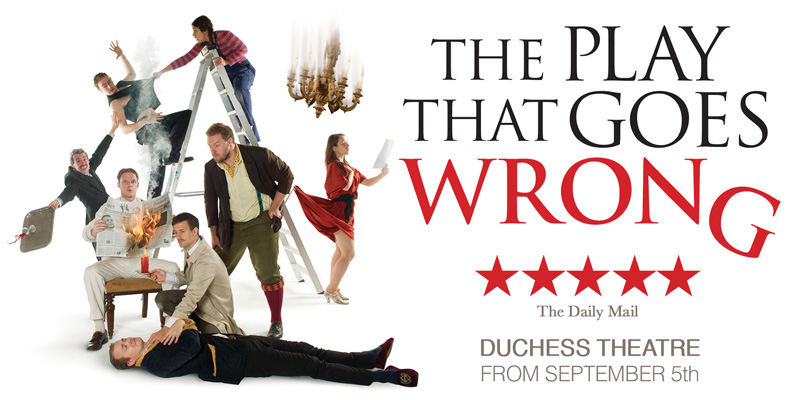A farce about a disastrous theatrical production is of course far from new, having been done most famously in Michael Frayn‘s infamous Noises Off, a backstage comedy that had me virtually wetting myself with laughter and which has been in constant production somewhere since the early 70s. I’m also fondly reminded of Michael Green‘s Art of Coarse Acting, which he later took to the Edinburgh fringe with a succession of “plays for coarse actors” – part of which was once performed on the Terry Wogan show on primetime TV, and which frightened the life out of the host when Green took off his trousers to reveal saggy tights!
The Play That Goes Wrong, written by Henry Lewis, Jonathan Sayer and Henry Shields of the Mischief Theatre Company, follows in that great tradition. It was all the more moot since I attended the play in Colchester with fellow members of the Kelvedon Players, amateur but never amateurish society of mummers who care with a passion about standards of production. It is such high standards that keen the flag flying for amateur dramatics up and down the country; I am proud to have performed with many such groups over a very period.
Funnily enough, the KPs recently did a production of the The Farndale Avenue Housing Estate Townswomen’s Guild Dramatic Society’s Production of Macbeth, one of a series of plays-within-a-play put on by incompetent (fictional) performers and crew in which, you guessed it, pretty much everything goes wrong – thus demonstratating we are not above sending ourselves up on occasion.
Not that things don’t go wrong in amateur – or for that matter professional – productions, but not all at once, and occasionally so the audience does not twig beyond the odd prompt. For example, the old chestnut about a line being repeated with the result of the cast endlessly repeating a section of dialogue has only occurred once in my 40-year dramatic career, and happily I was not on stage at the time! The programme reminds us of the oft-quoted yarn about Michael Redgrave‘s hearing aid, worn to receive prompts, picking up messages from a local taxi company.
Missing cues and having to ad lib is another favourite, but my most hilarious disaster was a wardrobe malfunction with cummerbund and trousers – though to my own credit I turned my back, did some running repairs and continued without missing a line, but did earn the biggest laugh of the night.
This particular example of the genre concerns the Cornley Polytechnic Drama Society amateur production of The Murder at Haversham Manor, containing all the cliches of a 1920s murder/ mystery play. In the course of which everything possible goes wrong – yep, they throw the kitchen sink at it and keep up the pressure relentlessly for 2 solid hours – including but not restricted to those mentioned above, then some.
Whether anyone would notice if anything went wrong with the going wrong is debatable, but if you thought they could easily disguise it you’d be very mistaken. The point is that to do disaster well requires split-second timing, infinitesimal control over set and props, and an impeccably rehearsed cast moving like greased lightening as required. Where some plays can cope with variance and ambiguity, creating random chaos requires, paradoxically, the greatest degree of precision.
I remember fondly doing Ray Cooney‘s Out of Order, a play in which a window falls on the heads of actors – for which the crew included a “fenestrator” to ensure it fell only when required so to do. Quite apart from window trouble in this case, we have opening and sticking doors, paintings, fixtures and fittings falling off, more things than I can possibly name breaking, a balcony study that loses its stanchion and becomes a lethal slope, and finally the flats collapsing in a style deliberately reminiscent of Buster Keaton’s epic building collapse in Steamboat Bill, Jr (see here.) One slip and an actor will be in hospital bandaged from head to foot.
Designing a set that falls to pieces on cue, but only on cue, is worthy of merit. This one does all of the above, and more. Not only that, but every component of the set and furnishings has multiple uses.
The physical components are remarkable, but to act in such slapstick requires not only fitness, timing, the ability to fall and take what look like painful blows, but still deliver lines and business on cue takes considerable skill, verve and bravado. My days of doing anything quite so vigorous are probably long gone, but I am awe-struck in admiration for actors who can do it with such immaculate precision, as if it were random chaos.
For the beautifully wrought mayhem, credit to Patrick Warner (as the long-suffering director Chris Bean and police inspector), Katie Bernstein (Annie, stage manager and enforced actor until she gets knocked out), Graeme Rooney (sound man Trevor, Duran Duran fan and much more), Jason Callender (Jonathan, long-suffering corpse who comes back to life, frequently), Edward Judge (Robert, the serious acTOR who suffers the indignity of having to cope with and compensate for failings in the set), Edward Howells (Dennis, awestruck company actor, apparently gay and much given to semaphore) and Meg Mortell (Sandra, leading lady knocked out at least twice and repeatedly undressed) for giving an excellent evening’s entertainment.
Trouble is, describing such mayhem for the benefit of a review is nigh on impossible. It starts with the stage crew well before curtain up (metaphorically, since the curtains are up as you enter the auditorium), includes a member of the audience and brings laughs. From that point on the gags come thick and fast, with some variance in pace but cumulatively more manic and hysterical. My friends and fellow performers were certainly killing themselves and applauding at regular intervals, and such is the relentless nature of the show that even the odd dud among the gags does not detract unduly from the feelgood triumph sending audiences home happy.
Truth be told, you’re killing yourself through Act 1 but in Act 2 it gets a bit too OTT, to the point where lines are being barked out on one side of the stage but not heard, while an all-female punch-up becomes ever more vindictive on the other. Too much is happening, but then that is what makes it a classic farce.
Example: Everyone has seen the grandfather clock gag with an actor hiding within. That happens twice over in TPTGW, but they take the joke to the next step by continuing to play while the character is inside the clock, taking it/her to the chaise longue and using the line that she should remove her hands from her face to do exactly that with the clock face. Good slapstick loses a lot in the retelling so there’s nothing for it – go see!










